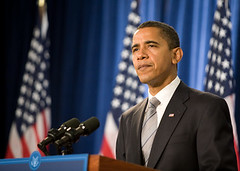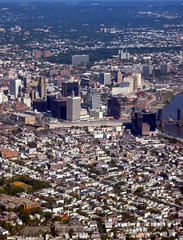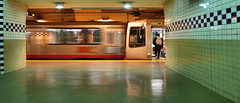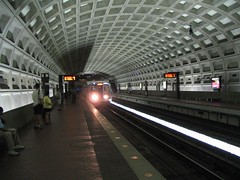Shovels Are In Motion, Says Obama
(Source: Whitehouse.gov via Planetizen)
The President and V.P. addressed the Department of Transportation today, stating that the new investment in infrastructure “will create or save 150,000 jobs by the end of next year, most of them in the private sector.”
Excerpts from the Vice-President Biden’s address:
Just two weeks after signing that legislation, we’re about to start the biggest investment on our nation’s road, bridges, highways and tunnels since we built the Interstate Highway System over 50 years ago. It’s a big deal. The work is beginning now, with hundreds more projects getting underway in the next few months. Some project will start this month, some won’t get going until the summer. We’re going to do everything we can to get them moving as quickly as possible. But Americans didn’t get in this mess overnight. And unfortunately, unfortunately, it’s going to take some time for us to get out of this.
Mr. President, you also made it clear that we have an obligation to the taxpayers of this nation to make sure their money is being used wisely, to make it accountable and transparent. Folks, we’re going to ask of you a sense of diligence and transparency and responsibility as has not been asked before, because we’ve never made this kind of investment before. This is a big deal. Never before in the history of this country have the people been more able to see with such complete transparency how we’re going to put their money to work, not just in this agency but particularly here.
Excerpts from President Obama’s address:
Of the 3.5 million jobs that will be created and saved over the next two years as a result of this recovery plan, 400,000 will be jobs rebuilding our crumbling roads, bridges, and schools, repairing our faulty levees and dams, connecting nearly every American to broadband, and upgrading the buses and trains that commuters take every day. Many of these projects will be coordinated by Secretary LaHood and all of you at the Department of Transportation. And I want you to know that the American public is grateful to public servants like you — men and women whose work isn’t always recognized, but whose jobs are critical to our nation’s safety, security, and prosperity. You have never been more important than you are right now, and for that we are all grateful. (Applause.)
Now, in the coming days and weeks, my administration will be announcing more details about the kinds of transportation projects that will be launched as part of the recovery plan. But today, I want to speak about an investment we are making in one part of our infrastructure. Through the Recovery Act, we will be investing $28 billion in our highways, money that every one of our 50 states can start using immediately to put people back to work. It’s an investment being made at an unprecedented pace, thanks in large part to Joe Biden, who’s leading the effort to get the money out the door quickly. Because of Joe, and because of all the governors and mayors, county and city officials who are helping implement this plan, I can say that 14 days after I signed our Recovery Act into law, we are seeing shovels hit the ground.








 Welcome to the inaugural issue of The Number Thirteen Line, a monthly blog about transportation in New York and around the world. This month’s topic: The Stimulus Package and its impact on
Welcome to the inaugural issue of The Number Thirteen Line, a monthly blog about transportation in New York and around the world. This month’s topic: The Stimulus Package and its impact on  Seven hundred and ninety billion dollars, as designated in the American Recovery and Reinvestment Act, is a lot of money. Frankly, we had hoped that most of it would go toward public works projects; after all, good infrastructure projects have been shown to produce five times the GDP impact of broad-based tax cuts. Nonetheless, we understand reality doesn’t always play out the way we’d like. So we are reasonably pleased to see that $130-billion, of the $790-billion bill (16%), is intended for construction projects.
Seven hundred and ninety billion dollars, as designated in the American Recovery and Reinvestment Act, is a lot of money. Frankly, we had hoped that most of it would go toward public works projects; after all, good infrastructure projects have been shown to produce five times the GDP impact of broad-based tax cuts. Nonetheless, we understand reality doesn’t always play out the way we’d like. So we are reasonably pleased to see that $130-billion, of the $790-billion bill (16%), is intended for construction projects.